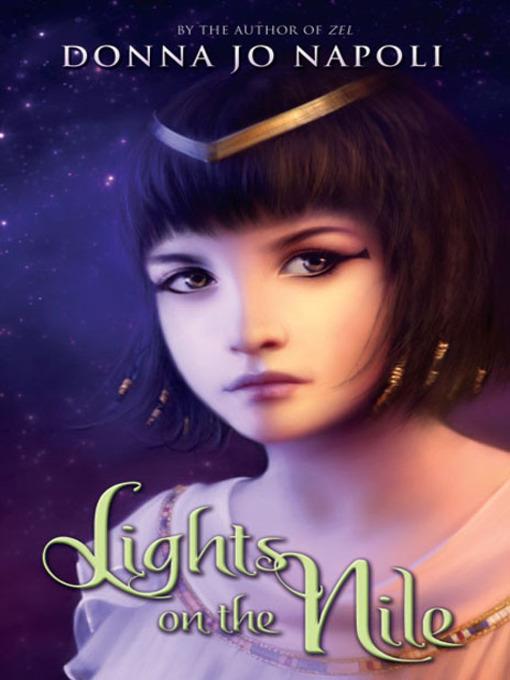
Lights on the Nile
فرمت کتاب
ebook
تاریخ انتشار
2011
Lexile Score
580
Reading Level
2-3
ATOS
4.1
Interest Level
4-8(MG)
نویسنده
Donna Jo Napoliناشر
HarperCollinsشابک
9780062093363
کتاب های مرتبط
- اطلاعات
- نقد و بررسی
- دیدگاه کاربران
نقد و بررسی

quackychicken - Lights on the Nile may be one of the best books I've ever read. It's one of my favorites because it really brings ancient Egypt back to life. This book includes lots of interesting facts about Egypt back in the day. This amazing book is great and I don't want its wonderfulness to go to waste so please read this book and I guarantee you'll enjoy it!!!

August 8, 2011
Living in ancient Egypt around 2530 B.C.E., 10-year-old Kepi inhabits a world very aware of the presence and power of gods and spirits. Her father is wounded while helping build a pyramid for the cruel Pharaoh Khufu, putting their family under financial stress. While collecting fruit Kepi is duped and kidnapped, along with her pet baboon, Babu, by a man who wants to travel north to the capital city of Ineb Hedj and sell Babu to the pharaoh. Strong-willed and wily, Kepi refuses to be separated from Babu during the turbulent journey, praying to the gods for protection and forming her own agenda: to confront the pharaoh about his neglect of his people. Napoli (The Wager) crafts a mystical coming-of-age tale and a love letter of sorts to Egypt, saturated with proverbs, intriguing details of everyday life at the time, and rich descriptions of the places Kepi visits (“The mornings were all misty green, as though someone had woven the finest cloth of fresh leaves and draped it over the world”). Kepi’s survival skills and perspective are challenged in this absorbing adventure. Ages 8–12.

August 1, 2011
Kepi's name means "tempest," and it suits, in this tale that purports to reveal the origins of fairies.
In 2530 B.C.E. Egypt, as the young daughter of a miller, her impetuousness lands her and her pet baboon captive on a boat sailing north on the Nile. As the journey progresses, plans to escape her kidnapper evolve into a quest to speak to the Pharaoh in the capital city, Ineb Hedj, to complain about his unfairness to his people. Kepi's spiritedness only seems to grow as she gets farther from her family, and the narrative progression may strike readers as unusual as her character only intensifies, rather than showing signs of change. The final, brief climax fulfills the arc—or rather, arrow—as Kepi and the companions she's gathered are transformed by the goddess Hathor into the world's first fairies. Napoli's text is full of detail of setting and culture that should enthrall young fans of historical fiction, though its resolution may leave them confounded. Conversely, readers who come to the story expecting fairy fantasy will be disappointed.
Nevertheless, the story offers rich fare for those precocious younger readers who can't get enough; with luck they will accommodate any confusion and may move onto some of Napoli's more polished works, a little later on. (author's note, glossary) (Historical fantasy. 8-11)(COPYRIGHT (2011) KIRKUS REVIEWS/NIELSEN BUSINESS MEDIA, INC. ALL RIGHTS RESERVED.)

September 1, 2011
Gr 4-8-Kepi is a spirited young ancient Egyptian girl with a powerful connection to animals, from the click beetle she discovers in her family's fields to the baby baboon she finds and raises. When some boys try to steal Babu, Kepi runs far from home in pursuit of her pet and falls prey to Menes, a man whose motives for helping her are unsettlingly ambiguous. Menes drugs her with poppy seedpods and transports her up the Nile to be a baboon trainer in a temple in Ineb Hedj, the capital of Egypt. Kepi's adventures make for fascinating reading, and Napoli smoothly integrates details about the landscape, political structure, religion, and daily life. Readers' hearts will be in their mouths as Kepi survives a sandstorm, reaches the capital, is forced into servitude, and confronts the Pharoah himself. That's where the story begins to feel as if it's barreling toward a too-hasty conclusion. And when Kepi and her new friends are transformed into feri, it seems mostly as if this sketchy explanation of the origin of fairies is Napoli's device to get Kepi back home.-Miriam Lang Budin, Chappaqua Public Library, NY
Copyright 2011 School Library Journal, LLC Used with permission.

September 1, 2011
Grades 4-7 In ancient Egypt, after her father is maimed while building a pyramid, Kepi works hard to help her family's bakery thrive. While hunting for spices to enhance the baking, Kepi and her trained baboon are kidnapped and trapped on a trade ship as it journeys along the Nile to the capital city. Kepi lives up to the meaning of her name (tempest), always plotting escapes. But she is also very devout: mindful of the gods she may be encountering, whether in the form of a crocodile, bird, or the moon, Kepi constantly prays and tries to honor them. The gods seem to be listening, as help surprises Kepi on her long and treacherous journey through port cities, hippo attacks, hunger, and more. Her devotion pays off when the moon goddess turns Kepi into a fairy to work in her service. Fans of Napoli's retold fairy tales may be disappointed that the fairy-tale portion begins as the book ends, but the blend of history and adventure keeps the story moving, with interesting detail to illuminate the time period.(Reprinted with permission of Booklist, copyright 2011, American Library Association.)

























دیدگاه کاربران